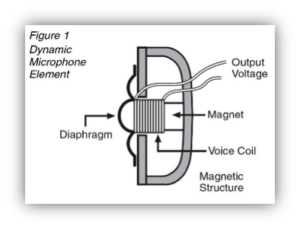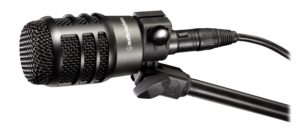What are the differences between the microphones that Audio-Technica offers? (Part 1 - Dynamic Mics)
Answer: Microphones are transducers, and they can be grouped conveniently according to their design features. For starters, we can categorize microphones by body or function type (handheld, side-address, headworn, etc.), and then further group them by the type of element they use (condenser, dynamic, etc.). We can even talk about element sub-types. For instance, condenser microphones generally come in two forms: electret condenser and DC bias condenser. Dynamic microphones also generally come in two forms: moving-coil and ribbon. It’s also useful to categorize microphones by polar pattern – cardioid, omnidirectional, hypercardioid, etc.
Audio-Technica manufactures both dynamic and condenser microphones. Their mechanical makeup is different and they perform differently, so they are often best suited for different types of applications. This week we’ll look at dynamic microphones and how they capture sound.
[caption id="attachment_1758" align="aligncenter" width="300"] Figure 1 - Dynamic Microphone Element[/caption]
Figure 1 - Dynamic Microphone Element[/caption]
The most common type of dynamic microphone is moving-coil (see Figure 1), which operates on electromagnetic induction. Moving-coil microphones utilize a diaphragm that, when moved by changing sound pressure, also moves the voice coil, causing electrical current to flow. As the diaphragm moves, the attached magnetic voice coil creates a positive charge and when the diaphragm rebounds from the voice coil, a negative charge is created. This is translated into positive and negative electrical current.
Another way to think of a dynamic microphone is as the reverse of a speaker. A speaker takes in electrical current that moves the speaker cone (diaphragm) and its voice coil. This vibrating movement of the speaker cone results in acoustic sound pressure – aka sound. The concept is the same as that of a dynamic microphone, just in reverse.
Dynamic microphones are rugged, reliable, and are often used in live applications where sound reinforcement is needed. Proper care and maintenance will extend the life and performance of dynamic microphones. These mics do not require any additional power or batteries for operation. Output levels are properly matched to work directly with most microphone level inputs for good signal-to-noise ratio. They are capable of smooth, extended frequency response for accurate reproduction of vocals and instruments. The frequency characteristic can also be tailored to suit particular applications. Examples are the ATM250 dynamic microphone, which is tailored for kick drum, percussion, brass, and other dynamic instruments, and the ATM510, which is designed primarily for use with vocals. It is important to note that moving-coil dynamic microphones do not require phantom power.
In our next Question of the Week, we’ll look at ribbon microphones and see how they capture sound. But if you have additional questions or need help finding the best Audio-Technica microphone for your needs, please don’t hesitate to contact our Audio Solutions Department.
